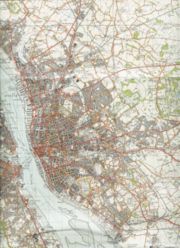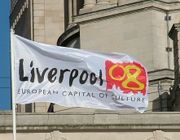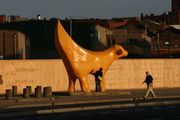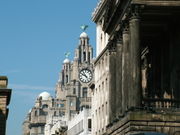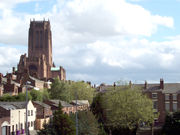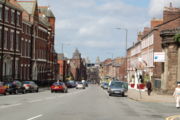Liverpool
2007 Schools Wikipedia Selection. Related subjects: Geography of Great Britain
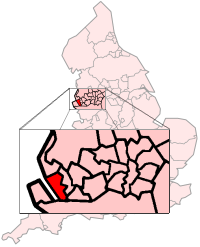 |
|
| Geography | |
| Status | Metropolitan borough, City (1880) |
|---|---|
| Region | North West England |
| Ceremonial county | Merseyside |
| Historic county | Lancashire |
| Area - Total |
Ranked 232nd 111.84 km² |
| Admin HQ | Liverpool |
| ISO 3166-2 | GB-LIV |
| ONS code | 00BY |
| OS grid reference | SJ437905 |
| Coordinates | 53°25N 3°W |
| NUTS 3 | UKD52 |
| Demographics | |
| Population: - Total (2005 est.) - Density |
Ranked 5th 447,500 4,001 / km² |
| Ethnicity | 94.3% White 1.1% S. Asian 1.2% Afro-Caribbean 1.2% Chinese |
| Politics | |
| Liverpool City Council |
|
| Leadership | Leader & Cabinet |
| Control | Liberal Democrats |
Liverpool is a city and metropolitan borough in North West England, along the eastern side of the Mersey Estuary.
Built across a ridge of hills rising up to a height of around 230 feet (70 metres) above sea-level at Everton Hill, the city's urban area runs directly into Bootle and Crosby in Sefton to the north, and Huyton Dovecot and Prescot in Knowsley to the east. It faces Wallasey and Birkenhead across the River Mersey to the west.
Liverpool is governed by Liverpool City Council, one of five councils within the Metropolitan county of Merseyside, and is one of England's core cities and its fifth most populous - 441,477 in 2002, with 816,000 in the Liverpool Urban Area, which includes suburbs on the Liverpool side of the Mersey but not those on the Wirral.
Inhabitants of Liverpool are referred to as Liverpudlians and nicknamed " Scousers", in reference to the local meal known as 'scouse', a form of stew. The word scouse has also become synonymous with the Liverpool accent and dialect.
In the late 19th century, Liverpool laid claim to being the "second Port of the Empire", handling more goods than any British city outside London. During the late 20th century, the decline of the Port of Liverpool as a source of employment and the later contraction of manufacturing industry in the city region badly affected the city's economy. However, the city's economy has grown strongly and faster than the national average since the mid nineties.
In 2007, the city will be celebrating its 800th anniversary, and in 2008, will hold the European Capital of Culture title.
History
King John's letters patent of 1207 announced the foundation of the borough of Liverpool and by the middle of the 16th century the population was still only around 500. In the 17th century there was slow progress in trade and population growth. A number of battles for the town were waged during the English Civil War, including an eighteen-day siege in 1644. In 1699 Liverpool was made a parish by Act of Parliament, that same year its first slave ship, Liverpool Merchant, set sail for Africa. As trade from the West Indies surpassed that of Ireland and Europe, Liverpool began to grow. The first wet dock in Britain was built in Liverpool in 1715. Substantial profits from the slave trade helped the town to prosper and rapidly grow. By close of the century Liverpool controlled over 41% of European and 80% of Britain's slave commerce.
By the start of the nineteenth century, 40% of the world's trade was passing through Liverpool and the construction of many major buildings reflected this wealth. In 1830, Liverpool (along with Manchester) became the first city to have an intercity rail link, through the Liverpool and Manchester Railway. The population continued to rise rapidly, especially during the 1840s when the Irish began arriving by the thousands due to the Great Famine. By 1851, approximately 25% of the city was Irish-born. During the first part of the 20th century, Liverpool was pulling in emigrants from across Europe. During World War II there were 80 air-raids on Merseyside, killing 2500 people and causing damage to almost half the homes in the metropolitan area. Since 1952 Liverpool has been twinned with Cologne, Germany, a city that shared the horrifying experience of excessive aerial bombing. Significant rebuilding followed the war, including massive housing estates and the Seaforth Dock, the largest dock project in Britain.
The population of Liverpool peaked in the 1931 census, which reported 855,688 inhabitants. This had declined to 610,114 by 1961, and further to 439,476 in the 2001 census.
In the 1960s Liverpool became a centre of youth culture. The " Merseybeat" sound which became synonymous with The Beatles and fellow Liverpudlian pop bands of the era catapulted the city to the front of the popular music scene. Economically however the city has been in decline since the 1950s with the loss of numerous employers and from the 1970s onwards Liverpool's docks and traditional manufacturing industries went into sharp decline. The advent of containerization meant that Liverpool's docks became largely obsolete. In the early 1980s unemployment rates in Liverpool were amongst the highest in the UK.
In 1974, Liverpool became a metropolitan district within the newly created metropolitan county of Merseyside, it had previously been in Lancashire. At the end of the century Liverpool was concentrating on regeneration which still continues today, with the city winning the accolade of European Capital of Culture for 2008. Capitalising on the popularity of the 1960s pop group The Beatles and other groups of the Merseybeat era, tourism has also become a significant factor in Liverpool's economy.
In 2004, property developer Grosvenor started the Paradise Project, a £920m development centred on Paradise Street, which will involve the most significant changes to Liverpool's city centre since the post-war reconstruction.
Culture
Liverpool is internationally known as a cultural centre, with a particularly rich history in popular music, performing and visual arts.
During the late 1960s, the city also became well known for the Liverpool poets, of whom Roger McGough and the late Adrian Henri are among the best known. The anthology The Mersey Sound, by Henri, McGough and Brian Patten, has sold over 500,000 copies since first being published in 1967.
In 2003, Liverpool was named European Capital of Culture for 2008. A series of cultural events during 2004-9 is planned, peaking in 2008.
Performing arts
A flourishing orchestra, the Royal Liverpool Philharmonic Orchestra performs in its own home, the Liverpool Philharmonic Hall, and Liverpool has a strong history of performing arts which is reflected in the number of theatres in the city.
- Empire
- Everyman
- Liverpool Playhouse
- Neptune
- Liverpool Philharmonic Hall
- Royal Court
- Unity
Several of the city's theatres have successful theatre companies, including the Everyman & Liverpool Playhouse and the Unity Theatre .
Visual arts
Liverpool has a vibrant artistic life. Several pre-Raphaelites are among the important paintings in the Walker Art Gallery. Sudley House contains another major collection of pre 20th century art . The Tate Liverpool gallery houses the modern art collection of the Tate in the north of England. The FACT centre hosts touring multimedia exhibitions.
The Liverpool Biennial is a festival of arts held (as the name implies) every two years. The festival generally runs from mid September to late November and comprises three main sections; the International, The Independents and New Contemporaries although many fringe events are timed to coincide. It was during this event in 2004 that Yoko Ono's work "My mother is beautiful" caused widespread public protest by exhibiting photographs of a naked woman's pubic area on the main shopping street. Despite protests the work remained in place.
The 2006 Biennial has recently started and will run to mid November, exhibitions can be found dotted around Liverpool City centre and include such things as the lions in front of St. Georges Hall being caged, and St. Lukes Church being filled with upturned boats, maps of the display along with some exhibitions can be found at FACT cinema/gallery.
Sport
Liverpool has two Premier League football clubs: Everton F.C. at Goodison Park and Liverpool F.C. at Anfield. Both teams have enjoyed a considerable amount of success, with Liverpool having won a record 18 League titles,The European Cup five times and the FA Cup seven times whilst Everton, who have been present in the top professional league longer than any other club, except Arsenal, having won nine league titles, the UEFA Cup Winners' Cup once and the FA Cup five times. During the 1980's both Clubs enjoyed huge success dominating both the league and cup competitions in England and Europe. Highlights of this period were the FA Cup finals of 1986 and 1989 involving both clubs.
County cricket is occasionally played in Liverpool, with Lancashire County Cricket Club typically playing one match every year at Liverpool Cricket Club, Aigburth.
Aintree Racecourse to the north of Liverpool in the adjacent borough of Sefton is home to the famous steeplechase, the Grand National. One of the most famous events in the international horse racing calendar, it is held over a number of days in early April of each year. In addition to horse-racing, Aintree has also hosted motor racing, including the British Grand Prix in the 1950s and 1960s.
Liverpool Harriers, who meet at Wavertree Athletics Centre are one of five athletic clubs. Liverpool has a long history of boxing that has produced John Conteh, Alan Rudkin and Paul Hodkinson and hosts high level amateur boxing events. Park Road Gymnastics Centre provides training to a high level. The City of Liverpool Swimming Club has been National Speedo League Champions 8 out of the last 11 years. Liverpool Tennis Development Programme based at Wavertree Tennis Centre is one of the largest in the UK . Liverpool is also home to the Red Triangle Karate Club, which provided many of the 1990 squad that won the World Shotokan Championships in Sunderland. Luminaries include Sensei Keinosuke Enoeda, Sensei Frank Brennan, Sensei Andy Sherry and Sensei Terry O'Neill, who is also famous for various acting roles.
Rugby league is played at amateur and student level within the city - the last professional team bearing the city's name was Liverpool City, which folded in the 1960s.
Landmarks
Liverpool contains over 2,500 listed buildings (of which 26 are Grade I listed and 85 are Grade II* listed). It is the inheritance of high-minded public spirit since the late 18th century, largely with Dissenter impetus, resulting in more public sculpture than in any UK city aside from Westminster, more listed buildings than any city apart from London and, surprisingly, more Georgian houses than the city of Bath. Many well-known architects are represented in Liverpool, including Peter Ellis, Harvey Lonsdale Elmes, John Foster, Sir Giles Gilbert Scott, Sir Edwin Lutyens and Sir Frederick Gibberd.
Waterfront
In 2004 Liverpool's waterfront was declared as a UNESCO World Heritage site, reflecting the city's importance in the development of the world's trading system and dock technology.
The docks are central to Liverpool's history, with arguably the best-known being Albert Dock: the first enclosed, non-combustible dock warehouse system in the world and the first structure in Britain to be built entirely of cast iron, brick and stone, designed by Jesse Hartley. Restored in the 1980s, the Albert Dock is the largest collection of Grade I listed buildings in Britain. Part of the old dock complex is now the home to the Merseyside Maritime Museum, Museum of Liverpool Life and the Tate Liverpool. Other relics of the dock system include the Stanley Dock Tobacco Warehouse, which at the time of its construction in 1901, was the world's largest building in terms of area.
The Pier Head is arguably the most famous image of Liverpool, the location of the Three Graces, three of Liverpool's most recognisable buildings. The first is the Royal Liver Building, built in the early 1900s and surmounted by two bronze domes with a Liver Bird (the symbol of Liverpool) on each. The second is the Cunard Building, the headquarters of the former Cunard shipping company. The third is the Port of Liverpool Building, the home of the former Mersey Docks and Harbour Board which regulated the city's docks.
In front of these buildings at the waters edge are the memorials to the men of the merchant navy who sailed out of the port during both World Wars. Memorials to the British mariners, Norwegian, Dutch and to the many thousands of Chinese seamen who manned Britain's ships cluster together here. Perhaps most intereting is the Chinese memorial to the men forcibly deported from the city after World War Two and to the families they left behind. see:
Places of worship
The thousands of migrants and sailors passing through Liverpool resulted in a religious diversity that is still apparent today. This is reflected in the equally diverse collection of religious buildings, and two Christian cathedrals.
The parish church of Liverpool is the Anglican Our Lady and St Nicholas, colloquially known as "the sailors church", which has existed near the waterfront since 1257. It regularly hosts to Catholic masses. Other notable churches include the Greek Orthodox Church of St Nicholas (built in the Byzantine style), and the Gustav Adolfus Kyrka (the Swedish Seamen's Church, reminiscent of Nordic styles).
Liverpool's wealth as a port city enabled the construction of two enormous cathedrals, both dating from the 20th century. The Anglican Cathedral, designed by Sir Giles Gilbert Scott, has one of the longest naves, largest organs and heaviest and highest peals of bells in the world. The Roman Catholic Metropolitan Cathedral was initially planned to be even larger; of Sir Edwin Lutyens' design, only the crypt was completed. The cathedral was eventually built to a simpler design by Sir Frederick Gibberd; while this is on a smaller scale than Lutyens' original design, it still manages to incorporate the largest panel of stained glass in the world. Appropriately enough, the road running between the two cathedrals is called Hope Street.
Liverpool has a number of synagogues, of which the Grade II* listed Moorish-revival Princes Road Synagogue is perhaps most notable. Liverpool has a thriving Jewish community.
The city had one of the earliest mosques in Britain, founded in 1887 by William Abdullah Quilliam, a lawyer who had converted to Islam. Currently the main mosque in Liverpool is the Al-Rahma mosque.
Other notable buildings
The area around William Brown Street has been labelled the city's 'Cultural Quarter', owing to the presence of the William Brown Library, Walker Art Gallery and World Museum Liverpool, just three of Liverpool's many neo-classical buildings. Nearby is St George's Hall, perhaps the most impressive of these neo-classical buildings, was built to serve both as a concert hall and as the city's law courts. Also in this area are Wellington's Column and the Seble Fountain.
Liverpool's Town Hall dates from 1754 and has a beautifully-designed interior.
The term Red Brick University, applied to many British universities dating from a similar period, was inspired by the University of Liverpool's Victoria Building, noted for its clock tower.
Some of Liverpool's landmarks are better known for their oddness rather than for their role. Williamson's tunnels are architecturally unique as being the largest underground folly in the world. The Philharmonic Dining Rooms are noteworthy for their ornate Victorian toilets, which have become a tourist attraction in their own right.
Education
In Liverpool primary and secondary education is available in various forms supported by the state include secular, Church of England, Jewish, and Roman Catholic. Islamic education is available at primary level, but there is currently no secondary provision.
One of Liverpool's important early schools was The Liverpool Blue Coat School; founded in 1708 as a charitable school, it continues today. The Belvedere School is one of the leading private schools in the city, along with Liverpool College founded in 1840 and Merchant Taylors' School. Another of Liverpool's notable senior schools is St. Edward's College, a former private high school located in West Derby. Historic grammar schools, such as the Liverpool Institute High School & Liverpool Collegiate, closed in the 1980s are still remembered as centres of academic excellence.
Liverpool has three universities, the University of Liverpool, Liverpool Hope University and Liverpool John Moores University. Edge Hill University, originally founded as a teacher-training college in the Edge Hill district of Liverpool, is now located in Ormskirk in South-West Lancashire.
The Liverpool School of Tropical Medicine, founded to address some of the problems created by trade, continues today as a post-graduate school in the University of Liverpool and is one of only two institutions internationally that house the de facto standard anti-venom repository.
Liverpool Hope University, founded in 1844, is situated on both sides of Taggart Avenue in Childwall and a second Campus in the City Centre (The Cornerstone). Hope is quickly making a name for itself within the Liberal Arts, the University has also enjoyed many successes in terms of high graduate employability, campus development, and a substantial increase in student applications from outside of the City.
Liverpool John Moores University was previously a polytechnic, and gained university status in 1992. It is named in honour of Sir John Moores, one of the founders of the Littlewoods football pools and retail group, who was a major benefactor.
The Liverpool Institute for Performing Arts was set up by (Sir) Paul McCartney in 1996, to train artistes and technicians. It is situated in the building which formerly housed the Liverpool Institute High School for Boys and is affiliated with Liverpool John Moores University. Recently, LIPA has been awarded the ability to issue its own degrees, and is moving towards becoming an independent higher education instution.
The city has one further education college, Liverpool Community College. The college will recruit around 21,000 students in the academic year 2006/07.
Transport
Mersey crossings
There are three tunnels under the River Mersey: one railway tunnel, the Mersey Railway Tunnel; and two road tunnels, Queensway Tunnel and Kingsway Tunnel.
The Mersey Ferry continues to provide an important link between Liverpool and the Wirral, as well as a tourist attraction. Made famous by the song Ferry Cross the Mersey by Gerry and the Pacemakers, the song is now played on the ferryboats themselves every time they prepare to dock at Liverpool after a tourist cruise.
The Mersey is crossed upstream from Liverpool at Runcorn and Widnes, by the Silver Jubilee Bridge (usually known simply as the "Runcorn Bridge") and the Runcorn railway bridge.
Airport
In 2001, Liverpool Airport, near Speke in the south of the city, was renamed Liverpool John Lennon Airport, in honour of the late Beatle John Lennon. The airport's logo consists of a sketch that Lennon had drawn of himself, and the words "Above us only sky", lyrics from his song Imagine. The airport was the starting point for many Beatles tours in the sixties, and image of the boys boarding planes there were seen throughout the world.
Port
In 2002 716,000 passengers used the Port of Liverpool, with the Isle of Man and Ireland being the two most important passenger routes.
Railways
Liverpool is served by the Merseyrail urban rail network. The sections in the city centre are mostly underground. It has three lines: the Northern Line, which runs to Southport, Ormskirk, Kirkby and Hunts Cross, the Wirral Line, which runs through the Mersey Railway Tunnel and has branches to New Brighton, West Kirby, Chester and Ellesmere Port and the City Line, only from Lime Street, for St Helens, Wigan, Warrington and Manchester.
The city's main railway station for longer-distance services is Lime Street station. Trains operate to destinations including London, Birmingham, Manchester, Preston, Leeds, Scarborough, Sheffield, Nottingham and Norwich.
Buses
Long distance coach services arrive at and depart from the Norton Street Coach Station. Local buses serve the whole of the city and its surrounding areas.
Historic
Historically, Liverpool had an extensive tram network; however, this was dismantled in the 1950s. From 1893 to 1956, the Liverpool docks were served by the Liverpool Overhead Railway. A number of other railway lines, such as the Canada Dock Branch from Edge Hill to Kirkdale, no longer see passenger services, or have been removed completely, such as the North Liverpool Extension Line.
Proposed
In 2001 a plan to build new a light rail system, Merseytram, was developed. After central government insisted on additional guarantees prior to the release of previously committed funds, it was cancelled in November 2005. However, it is to be included in the transport plan from 2006-2011, as it is deemed to be an important part of Liverpool's development.
Famous Liverpudlians
A great many famous names have been associated with Liverpool; see Liverpudlians.
Liverpool has also played a large part in UK (and sometimes world) Pop Music culture since the 1960s. For a list of some noteworthy groups from the area, consult the list of famous bands from Liverpool.
Economy
This is a chart of trend of regional gross value added of Liverpool at current basic prices published (pp.240-253) by the Office for National Statistics with figures in millions of pounds sterling.
| Year | Regional Gross Value Added | Agriculture | Industry | Services |
|---|---|---|---|---|
| 1995 | 4,394 | 3 | 950 | 3,440 |
| 2000 | 5,681 | 4 | 1,033 | 4,644 |
| 2003 | 6,595 | 6 | 953 | 5,636 |
The economy of Liverpool is beginning to recover from its long, post-World War II decline. Between 1995 and 2001 GVA per head grew at 6.3% annum. This compared with 5.8% for inner London and 5.7% for Bristol. The rate of job growth was 9.2% compared with a national average of 4.9% for the same period, 1998- 2002. However, Liverpool is still comparatively poor; a 2001 report by CACI showed that Liverpool still had four of the ten poorest postcode districts in the country.
Like the rest of the United Kingdom the city has seen a large growth in the service sector, both public and private. Government offices include parts of the National Health Service and Home Office agencies such as the Criminal Records Bureau and the Identity and Passport Service, formerly the UK Passport Agency. Private sector service industries have invested in Liverpool too with several major call centres opening of late. The activities of the port have left the site with a communications infrastructure that had for a long time exceeded requirements.
Growth in the areas of New Media has been helped by the existence of a relatively large computer game development community. Sony based one of only a handful of European PlayStation research and development centres in Wavertree, after buying out noted software publisher Psygnosis. Indeed, according to a 2006 issue of industry magazine 'Edge' (issue 162), the first professional quality PlayStation software developer's kits were largely programmed by Sony's Liverpool 'studio' — the console has since become one of the World's most successful consumer products ever.
Tourism is a major factor in the economy and will be of increasing importance in the run up to the Liverpool's year as European Capital of Culture. This has led to a great increase in the provision of high quality services such as hotels, restaurants and clubs. The buildings of Liverpool not only attract tourists but also film makers, who regularly use Liverpool to double for many cities around the worlds and making it the second most filmed city in the UK.
Twin towns
Liverpool participates in international town twinning schemes to foster good international relations. Partners include:
 - Cologne (German: Köln), Germany
- Cologne (German: Köln), Germany - Corinto, Nicaragua
- Corinto, Nicaragua - Dublin, Ireland
- Dublin, Ireland - Liverpool, New South Wales, Australia
- Liverpool, New South Wales, Australia - Odessa, Ukraine
- Odessa, Ukraine - Rotterdam, Netherlands
- Rotterdam, Netherlands - Shanghai, People's Republic of China
- Shanghai, People's Republic of China
Trivia
In a competition organised by the conservation charity Plantlife in 2002, the sea-holly was nominated as Liverpool's county flower.
Alois Hitler, Jr. the half-brother of Adolf Hitler lived in the city, was married, and had a child. There is a rumour that Adolf visited Liverpool in 1911 before the outbreak of World War I, and that he drank in the Poste House pub on Cumberland Street.
Districts of Liverpool
Districts of Liverpool include:
- Aigburth, Allerton, Anfield
- Belle Vale, Broadgreen
- Canning, Childwall, Clubmoor, Croxteth
- Dingle, Dovecot
- Edge Hill, Everton
- Fairfield, Fazakerley
- Garston, Gateacre, Grassendale
- Hunts Cross
- Kensington
- Kirkdale, Knotty Ash
- Mossley Hill
- Netherley, Norris Green
- Old Swan
- St Michael's Hamlet, Speke, Stoneycroft
- Toxteth, Tuebrook
- Walton, Wavertree, West Derby, Woolton
Council wards
City council wards of Liverpool include:
- Allerton and Hunts Cross, Anfield
- Belle Vale
- Central, Childwall, Church, Clubmoor, County, Cressington, Croxteth
- Everton
- Fazakerley
- Greenbank
- Kensington, Kirkdale, Knotty Ash
- Mossley Hill
- Norris Green
- Old Swan
- Picton, Princes Park
- Riverside
- Speke Garston, St Michaels
- Tuebrook and Stoneycroft
- Warbreck, Wavertree, West Derby, Woolton
- Yew Tree
Parliamentary constituencies and MPs
Liverpool has five parliamentary constituencies: Liverpool Garston, Liverpool Riverside, Liverpool Walton, Liverpool Wavertree and Liverpool West Derby. At the 2005 general election, all were held by the Labour Party, and are represented by Maria Eagle, Louise Ellman, Jane Kennedy, Peter Kilfoyle and Robert Wareing respectively.
